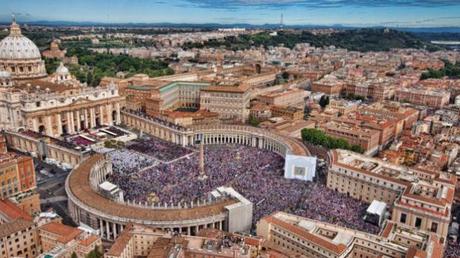
The Mystical Body of Christ – the Church
A lot of questions, contentions and assertions, often contradictory, have arisen lately about the matter of who is, or is not, part of the Church, the Mystical Body of Christ. Some have been correct. However, by far, the larger part of the contentions and assertions have all been either just partially correct or flat-out wrong. Some have been fueled by inadequate knowledge; others have been fueled by partisan denominational agendas. Misunderstandings and misrepresentations abound. Let us look, therefore, at who and what constitutes the Church.
The Church is made up of three parts: the (1) Church Triumphant, which consists of all those persons who are now in Heaven, enjoying the Divine Family in a direct manner. The (2) Church Suffering, which consists of all those souls who are still being purified in Purgatory, but who have now attained the assurance of reaching Heaven once their purification has ended. And (3) the Church Militant, the visible Church that consists of all those people on earth who are part of the Body of Christ.
How does one become part of the Mystical Body of Christ, the Church?
Entrance into the Body of Christ is through baptism of which there are three kinds: (1) the baptism of water, (2) the baptism of blood, and (3) the baptism of desire. Any person who receives any one of the above kinds of baptism is Christian, hence part of the Mystical Body of Christ (Paul VI, 1964. Lumen Gentium, Dogmatic Constitution on the Church). This is the official teaching of the universal Church, the fullness of which resides in the Catholic Church.
1) Baptism of water
The baptism of water occurs either formally by a priest/deacon as part of an official denomination of a Christian Church, or informally as in the case of either a physical emergency or when a priest/deacon are long-standingly unavailable as in the case of underground churches in still-existent Communist countries. The trinitarian formula is used in both cases and water is poured three times on the head of the person being baptized in accordance with the formula of the rite.
Any person can baptise another person as long as the former both uses the correct formula (“I baptize you + in the Name of the Father, + and of the Son, + and of the Holy Spirit”) and holds the appropriate intent. Even an atheist or other non-believing person can do this. It would be both valid and licit in the eyes of the Church, especially if said baptism take place in restrictive circumstances.
If you are baptized, therefore, into the Catholic Church, you are Christian. If baptized into the Orthodox Church, you are Christian. And if you are baptized into a Protestant ecclesial community, you are Christian. In all three cases, you are part of the Body of Christ – despite the interdenominational fights, rivalry, and one-upmanship. All three are Christian in the eyes of God. However, please note that any other forms of baptism by water are not valid, no matter how much their proponents may claim otherwise.
2) Baptism of blood
The baptism of blood occurs when a non-baptized person is killed for the Faith – either he or she professes Christ before being killed or refuses to denounce Christ or both. One of the most visible and recent cases in this regard was that of Saint Mathew Ayairga, one of the new martyrs of Libya. Saint Mathew was an unbeliever. However, when forced to kneel down by the Islamic State of Iraq and Levant (ISIL) and asked at swordpoint if would denounce Christ so that his life could be spared, he told his executioners, “Their God [of the Coptic Christians] is my God.” At that, he was instantly beheaded for Christ.
Any individual, inside or outside the visible Church, who maintains that Mathew was (a) not part of the Body of Christ at the very moment of his death, (b) is not now in Heaven enjoying God, or (c) that he is not a saint because he was not formally baptized by water is a liar. This holds true irrespective of whether the propagated lie is intentional or unintentional. The baptism of blood is as valid in the eyes of both God and the universal Church as the baptism of water.
3) Baptism of desire
The baptism of desire occurs when a non-baptized person intensely desires to become part of the Body of Christ, desires to belong to the One, True God – the “Unknown God” (Acts 17:23), as it were – but for a serious and/or valid reason is unable to be baptized by water. Such is the case, for example, of people in various regions who may not have adequate knowledge of the Faith, hence little-to-no knowledge of how baptism could be formally or informally carried out, but desire very much in the depths of their heart to become part of God and belong to Him. God the Father does not deny anyone the opportunity to become part of the Body of His Son, to enter His Divine Heart, irrespective of the mode of baptism as entry route. Unlike some of His people on earth, God is neither exclusionist nor partisan.
All three kinds of baptism that have been referenced above, therefore, are equally valid in the eyes of both God and the universal Church. All of them result in a person becoming Christian and a part of the Mystical Body of Christ. Extra ecclesiam nulla salus.
Many people fail to adequately comprehend the infinite love and mercy of God, and the true nature of the Church.

